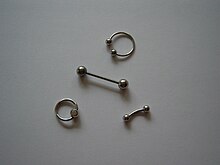Barbell (piercing)
A barbell (Engl. Dumbbell ) is a special variant of modern piercing jewelry in the form of a metal pin with thread and screw-balls. It is often worn through the tongue piercing , but it can also be used for many other piercings . Together with the Ball Closure Ring , it belongs to the standard piercing jewelry. It bears the name because of its shape, similar to a dumbbell .
history
In 1975, the American piercer and artist Jim Ward , who had been experimenting with piercing since 1967, met in the Texan town of Reno on Horst Linienbach , who ran a "studio for skin and body jewelry" in Frankfurt am Main and traveled regularly to the USA. Streckenbach, even tattoo Samy called, was due to its mechanic training together with his student Manfred Kohrs not only tattoo machines designed but also body jewelry made. Including a metal pin with screwable balls, which Kohrs first made in 1976. Jim Ward was inspired by this, and later the barbell came about.
construction
A barbell is a usually straight pin, usually made of steel or titanium and with two threaded ends that are closed with screw balls.
Usual material thicknesses of the rod are 1.0; 1.2; 1.6; 2.0; 2.4; 3.2; 4; 5; 6; 8 and 10 millimeters, the balls are usually symmetrically dimensioned. Their minimum diameter depends, of course, directly on the strength of the rod. When using balls with gemstones, it must be taken into account that with very small external threads the required minimum diameter must be slightly larger than with smooth metal balls, so that there is enough space inside for thread and stone. Instead of round balls, you can also choose any other form of lock. They range from hemispheres to plates, cylinders and cones ( spikes ) to entire sculptures .
A locking ball can be screwed onto barbells with an external thread at the ends. Since these external threads can irritate the tissue during insertion and removal or even cause it to tear, they are mostly only used if the material thickness is too small for an internal thread. Internally threaded rods are smooth at the ends. The thread is worked into the pin. The locking ball has an external threaded pin with which it can be screwed into the ends of the barbell. This variant is usually more complex and expensive to manufacture.
Special forms
In addition to the straight barbell, there are several variants with different curvatures. The curved barbell (also called bananabell or because of its shape banana ) has a slightly curved shape and is mostly used for navel piercing , typically with a smaller locking ball and a larger and decorated eye catcher .
The circular barbell (also horseshoe ) is bent so far that it has the shape of an open ring or horseshoe .
Smartie Beads are not screwed to a ball, but to a specially flattened section and are therefore particularly suitable for use in widened piercings , especially in the tongue.
So-called surface bars (in the form of a staple ) have a 90 or optionally 45 degree curvature at both ends in the same direction and are used for surface piercings. They reduce the tension and thus minimize the risk of migration (outgrowth). In most cases, their length is individually adapted to the length of the branch canal during manufacture.
Since the spreading of a clamping ball ring becomes increasingly difficult with thicker material diameters of the jewelry , there is a variant of the horseshoe ring in which the opening is so small that a screwed-in ball just fits in and thus the appearance of a closed ring is simulated.
PTFE barbells
Barbells made of PTFE material are used for better compatibility . On the one hand, these are soft and flexible, and on the other, they are allergy-neutral. A decisive advantage of Teflon over other suitable plastics is the fact that it can be sterilized in steam without any problems and is therefore also suitable for first-time use. The motifs or locking balls have a thread that cuts into the soft material of the pen when screwed on. They are especially used for navel piercings during pregnancy when the abdominal wall bulges outwards. They are also available as cord material in different strengths and can be individually adapted.
Web links
Individual evidence
- ↑ Phillipp Schaab: How the piercing became famous in Germany. In: Tattoo Magazine 07/20 (# 293), pp. 80–81 from June 19, 2020.
- ↑ Jessica Chesler: The Social History of Piercing. MTV NEWS 2003
- ↑ ezetraining.com.au / see also: Chesler, Jessica (2003). The Social History of Piercing. MTV NEWS ( Memento of March 4, 2016 in the Internet Archive ), accessed on September 15, 2013
- ^ Manfred Kohrs : Horst H. Linienbach the forgotten pioneer. In: Tattoo Kulture Magazine Issue No.32 of April 12, 2019, pp. 28-40.



